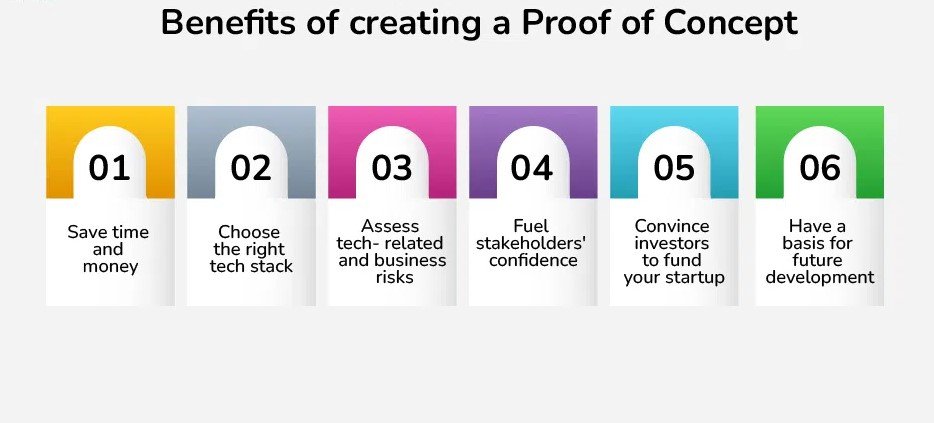Generating an idea is just the first step. The most difficult part is transforming the idea into a workable, scalable, and user-centric web application that can add value to your business. In the case of web development, a Proof of Concept (PoC) serves as a crucial step during the development lifecycle. A PoC reduces effort and cost while aligning expectations by validating ideas early, before committing resources to large-scale development.
This article delves into the meaning of PoC, its importance in web development, its advantages for businesses, and how one can successfully achieve them.
Defining Proof of Concept (PoC)
A Proof of Concept is a preliminary version or mini-project implemented to validate a concept by confirming both technical and business feasibility. It is not intended to be polished; rather, it should be a minimalist and minimalistic attempt at executing a single or multiple key features.
Consider a Proof of Concept as an experiment – it helps answer questions such as:
Is it possible to technically construct this?
Will the users appreciate or comprehend the inclusion of this functionality?
Is there a definable development and scalability pathway?
For instance, if you are creating a marketplace application, a proof of concept may address user registration and the ability to list products to validate that the primary functions of the application are operational.
What are the Reasons for a PoC in Web Development?
1. Validation of Concepts
In web development, especially for new and intricate designs, a significant amount of risk poses within the project. Everything from failures during integration to the adoption by end users can go wrong. The proof of concept is effective in identifying technical shortcomings or inaccuracies around which constructs may be designed to address more efficiently.
2. Effective Use of Financial Resources and Time Investments
A proof of concept validates an idea through building a PoC on a scale that isn’t likely to spend too many resources, and therefore avoids investing in technologies or features that may not work easily. You eliminate sunk costs and increase decision speed as you don’t have to build the entire app to figure out later that a critical part won’t function properly.
3. Stakeholder Buy-In
Investors, executive teams, and potential customers are all shown working models to build credibility. Stakeholders can offer feedback or funding with greater confidence when they witness a bare-minimum version of the product in action.
4. Technical Feasibility
Some concepts may be appealing at first glance, but in practice, they pose technical difficulties. A PoC enables proprietary testing of frameworks, APIs, integrations, and databases to ensure every critical component aligns with the organization’s goals.
5. Market Validation
Feedback gathered from a target audience is paramount. With a well-established PoC, feedback, opinion, and usability testing can be collected from actual users. This assesses the existence of a market need and whether the designed web solution meets that need.
How PoC Differs From MVP and Prototype
While it may seem like PoC overlaps with MVP and Prototype, the distinctions lie in their intended functions:
Proof of Concept (PoC): Validates technical and conceptual viability.
Prototype: Shows user experience and interface interaction sentiment.
MVP: Any product version that provides basic functionality and is released to users for feedback.
As is the case with most workflows, PoC comes before both the MVP and prototype.

When Should You Use a PoC?
New Startups: If you are pursuing a novel idea, and the technology or market is unfamiliar.
For New Innovative Features: When there are unprecedented features planned for the product.
Complex Integrations: When the problem involves third-party APIs or services.
Scalability Worries: When it is uncertain how the platform will perform with an increase in users or additional functionality.
Internal Systems: To conduct checks on new systems or workflows for corporate applications.
Critical Steps in Formulating a Proof of Concept
1. Define Objectives Clearly
What precisely do you seek validation for? Break down your objectives: it can be anything from being able to log in to a system, attach a payment system, or employ a fresh JS framework.
2. Determine Core Functionality
Place focus solely on what needs to be done to prove the concept. Do not engage in UI polishing or attempt to add non-essential features.
3. Allocate Resources Efficiently
Work with a streamlined team to design your PoC. This lowers the budget and increases speed, and is ideal when tailored for experts who can navigate complexities and make fast changes.
4. Validate and Iterate Quickly
Proof of concept (PoC) development requires speed. Make use of tools, frameworks, or other available resources to get something. Then, test rigorously to get what works and what doesn’t.
5. Collect Feedback and Capture Technical Insights
Share the PoC with users or key stakeholders after development, and gather feedback. Capture the technical insights alongside other recommendations for enhancement. This allows the development team to plan the next steps for building an MVP or a final product.
Real-life case studies
Numerous succeeding technology behemoths started with PoCs.
The file-sharing service Dropbox, perhaps most famously, launched with a single video that served as a PoC for demonstrating how file syncing would work. Feedback from early adopters helped shape the final product.
Airbnb proved the PoC for the market need by building a basic listing website where people could list their properties and allow them to rent out their homes.
All three examples above showcase testing and iterating before implementing a fully-fledged design can save time and result in a successful product.
Limitations of a PoC
Validated concepts, like all other strategies, have shortcomings. Listed below are areas of concern:
Strategic focus: Trying to do too much creates a complexity-oriented PoC.
Ignoring User Contribution: Failing to capture or act on feedback is detrimental to its purpose.
Lack of Clear Metrics: Not understanding what success looks like can result in misguided outcomes.
Abandonment After PoC: The idea isn’t necessarily bad just because PoC doesn’t work; it might simply require some adjustments.
Table of Contents
Final Thoughts
In web development, there is no shortage of ideas. However, achieving business success requires executing those ideas in a validated manner. A Proof of Concept offers a framework through which one can test assumptions, mitigate risk, and bolster confidence among stakeholders. It is a tactical, strategic investment that is limited in scope yet abundant in influence.
If you are a founder of a startup, a product manager, or a CTO, incorporating PoCs within your development workflow can greatly improve your chances of successfully and frequently deploying innovative web solutions.



